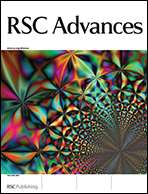Preparation and liquid-phase exfoliation of graphite fluoroxide towards graphene fluoroxide†
Abstract
As a new graphene derivative, graphene fluoroxide (GFO) has not been fully studied because of its complex preparation process. In this paper, two simple methods, a modified Hummers' method and an improved method, were adopted to oxidize unsaturated commercial graphite fluoride (GIF) to prepare graphite fluoroxide (GIFO), the precursor of GFO. GFO was finally obtained via liquid-phase ultrasonic exfoliation of GIFO in organic solvents. Multiple spectroscopic techniques were used to characterize GIFO and GFO. The test results indicate that both of the two methods can covalently bond oxygen functional groups to graphene fluoride (GF) sheets successfully, but the modified Hummers' method gives higher yield and oxidizability. The structure of the GFO sheet is confirmed as few-layer by its atomic force microscopy results and transmission electron microscopy images. UV-vis and fluorescence emission measurements suggest that introducing oxygen groups into GF sheets can change their optoelectronic properties. Based on this, GFO with tunable optoelectronic properties might be facilely obtained in large batches through oxidization and liquid-phase exfoliation of unsaturated GIF with different fluorine coverage.


 Please wait while we load your content...
Please wait while we load your content...